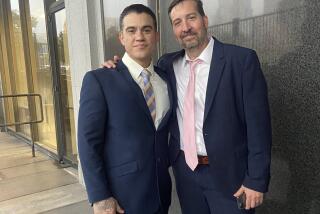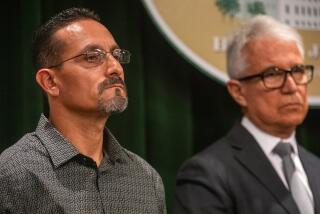Guard Found Not Guilty of Murder in High-Tech Trial : Courts: ‘This was a classic reasonable doubt case,’ jurors told lawyers. Prosecutors relied on DNA and other scientific evidence.
- Share via
Prosecutors had hoped that a battery of high-tech evidence would help them prove a Torrance security guard had turned on a woman he was supposed to protect, strangling her after he surprised her during a late-night burglary.
But on Wednesday, jurors acquitted a tearful Keith Campbell of all charges, removing the death-penalty threat that had hung over him and setting him free from the jail cell he has occupied for more than three years.
In a fitting end to a case plagued from the start by bureaucratic glitches, the County Jail system kept Campbell in jail one more night, finally releasing him Thursday afternoon.
“He’s been in hell,” defense attorney Leslie Abramson said. “It was a scandal for (prosecutors) to seek death in a case where they had nothing but very, very tenuous circumstantial evidence . . . but it’s over now and I just hope Keith has a good life.”
Jurors deliberated nearly five days before concluding that Campbell, 27, was not guilty of trying to rape and then strangling local golf star Tracy Morrigan as she spent her first night in her new Plaza del Amo townhome on May 30, 1989.
The jury, which heard the case in Norwalk Superior Court and deliberated in Los Angeles Superior Court because of overcrowding problems in the Torrance courthouse, told attorneys afterward that “this was a classic reasonable doubt case,” Abramson said.
Prosecutors believed they had good enough evidence to seek the death penalty when they filed murder charges against Campbell.
“But we knew it was a tough one all the way along the line and we gave it our best shot. We have no regrets,” said Deputy Dist. Atty. Bob Martin, who postponed his retirement to complete the case. “We pulled every plug that was available and we worked weekends and nights, putting our hearts and souls into this because we believed in it. When the justice system comes out and says it’s not there, I accept it.”
In addition to Campbell’s fingerprints being found on a bent window screen inside Morrigan’s townhouse, Martin based much of his case on high-tech sleuthing.
Technicians were called in to use special chemicals and a mobile laser unit to enhance a faint palm print found on a second-floor windowsill. Experts called by the prosecution concluded that the print was Campbell’s, but a defense expert testified that it was difficult to be sure.
In addition, the case became the first in Los Angeles County to allow evidence from replicated DNA, in this case gathered from the follicles of three pubic hairs found at the crime scene.
Using a relatively new process called polymerase chain-reaction testing, experts concluded that some of the hairs found on and around Morrigan’s body were genetically similar to Campbell’s.
But because of the limited genetic material that can be measured, the tests provide little more certainty about who the perpetrator might be than does standard blood typing. Experts believe Campbell’s genotype may be found in roughly 17% of the general population, or about one in six people worldwide.
Lawyers on both sides acknowledged after the verdict that the case was complicated by glitches in the investigation immediately after Morrigan’s death.
Too many people were allowed into the crime scene before Morrigan’s body was removed and the location was vacuumed for microscopic evidence, including the pubic hairs used as the basis of the DNA evidence.
A coroner’s investigator called to the scene could not determine an exact time of death because the thermometer he would have used to measure Morrigan’s body temperature was broken and the county had not replaced it.
When Torrance detectives asked for fingerprint identification cards for security guards who worked at the complex, the security company accidentally submitted the wrong card for Campbell. Detectives did not notice the error for nearly five months.
Campbell was arrested at that time, but it was not until after he was in custody that technicians were asked to conduct the chemical and laser examination of the palm print.
“It was really sleazy work and to make it a . . . death penalty case was the really disgraceful part,” Abramson said.
More to Read
Sign up for Essential California
The most important California stories and recommendations in your inbox every morning.
You may occasionally receive promotional content from the Los Angeles Times.













